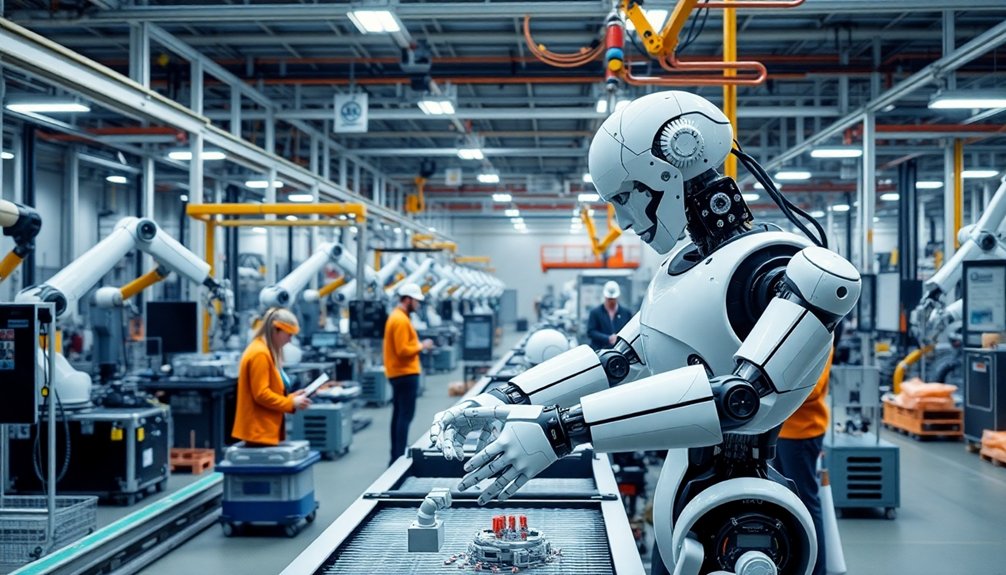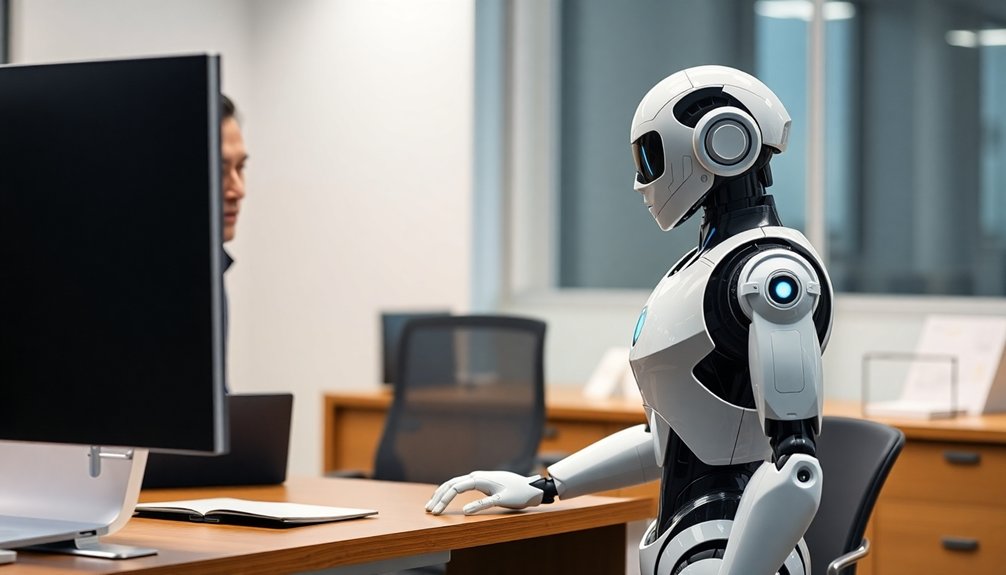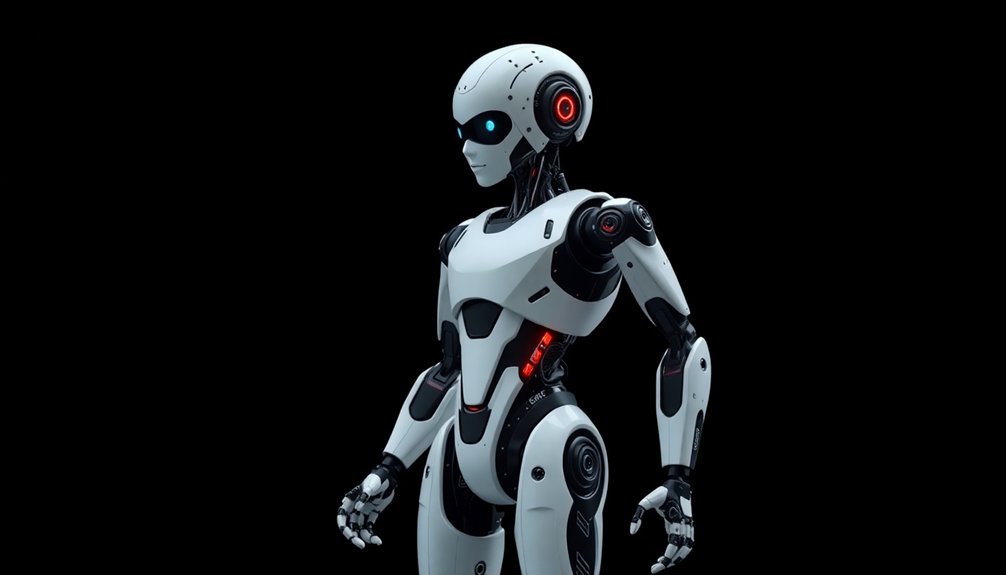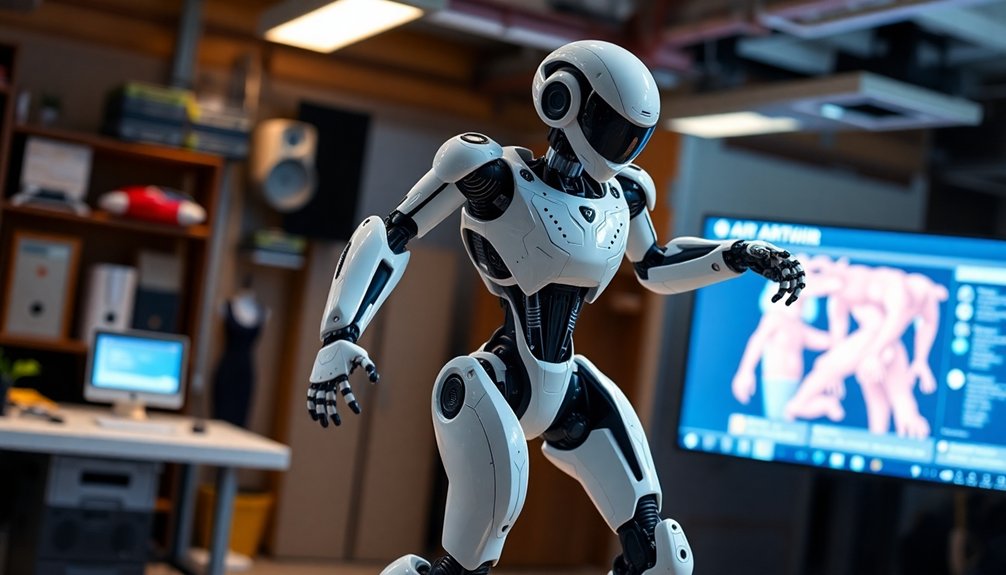Table of Contents
By 2030, we’ll see humanoid robots transforming work as we understand it. Think smart factory teammates, hospital helpers, and urban navigators. These aren’t clunky machines, but adaptive AI-powered partners learning and improving daily. They’ll tackle worker shortages, boost productivity, and reshape entire industries. Imagine robots delivering meds, managing traffic, and collaborating seamlessly alongside humans. Skeptical? The future’s closer than you think—and way more interesting than any sci-fi movie.
Manufacturing Revolution: How Robots Will Transform Factory Floors

Imagine factory floors where humans and robots dance a synchronized ballet of productivity. By 2030, humanoid robots won’t just be fancy machinery—they’ll be intelligent teammates solving complex manufacturing challenges.
Picture a BMW production line where robots seamlessly handle tasks that once required human hands, filling critical labor gaps while boosting efficiency. Warehouse robotics market is projected to reach USD 17.98 billion by 2032, indicating massive potential for industrial automation. We’re talking about machines that can learn, adapt, and make real-time decisions, transforming how we think about automation. Robotic cost parity means these advanced machines are becoming economically feasible for widespread industrial deployment.
Robotic innovation transforms manufacturing: intelligent machines seamlessly bridging human capability with adaptive, real-time automation.
With global manufacturing facing an 8-million-worker shortage, these robots aren’t just cool tech—they’re a workforce revolution. They’ll handle the repetitive, dangerous jobs while humans focus on strategy and innovation. By 2027, companies like Tesla plan to deploy Optimus robot production in their own factories, setting a precedent for widespread industrial robotics integration.
And the best part? These robots are getting smarter, more dexterous, and cheaper every single year. Manufacturing’s future isn’t about replacing humans—it’s about empowering them.
Urban Navigation and Public Service Breakthroughs
While technology races forward at breakneck speed, our cities are about to get a serious upgrade with humanoid robots that’ll make urban life look like a sci-fi movie come to life.
Imagine robots managing traffic flow, translating languages on the spot, and helping folks with disabilities navigate public spaces. These aren’t just fancy toys—they’re sophisticated assistants armed with advanced sensors and computer vision that can understand complex 3D environments better than most humans. Advanced perception systems will enable these robots to detect potential urban hazards instantaneously and react with precision that surpasses human capabilities. LiDAR and radar technologies will provide these robots with superhuman environmental mapping abilities, allowing them to navigate through urban landscapes with unparalleled accuracy.
From emergency response systems to multilingual support in public venues, these robots will transform how we interact with urban landscapes. They’ll work seamlessly with smart city infrastructure, processing data faster than you can blink and making our chaotic cities run smoother than a well-oiled machine. By 2050, with over 930 million humanoids expected for industrial and commercial use, these urban assistants will represent a massive technological transformation in how cities operate and serve their populations.
The $100,000 Robot: Economic Feasibility and Workplace Integration

As the price tag of humanoid robots drops closer to the cost of a luxury car, we’re witnessing a technological revolution that’s about to rewrite the rules of work. Global Market Potential A sixfold market increase from $6 billion to $38 billion by 2035 signals massive economic transformation. Market Expansion Asia Pacific is projected to lead this robotic workforce revolution with the highest growth rate in humanoid robot adoption. Workforce Adaptation will require continuous learning as AI technologies transform traditional employment models.
By 2030, these metallic colleagues will be more than just sci-fi fantasies—they’ll be practical workforce partners transforming industries from construction to elder care.
The economic math is compelling:
- Robots cutting $30,000-$150,000 per unit will solve critical labor shortages
- Autonomous decision-making capabilities mean less supervision, more productivity
- Versatile machines like Apptronik’s Apollo can adapt across multiple demanding sectors
We’re not talking about job replacement, but job reimagination.
These robots aren’t here to steal careers—they’re here to tackle tasks humans find repetitive, dangerous, or frankly, boring.
Welcome to the future of work: where machines do the grunt work, and humans get to be, well, human.
Healthcare’s New Workforce: Robots as Care Assistants and Medical Helpers
By 2030, hospitals won’t just have nurses and doctors—they’ll have robotic teammates silently revolutionizing patient care.
Imagine a metal assistant gliding through hallways, delivering meds, transporting lab samples, and monitoring essentials without breaking a sweat. These humanoid helpers aren’t replacing humans; they’re filling critical workforce gaps and reducing burnout. Fourier GR-1 robots are specifically designed to perform tasks like transferring patients from bed to wheelchair, showcasing the practical potential of medical robotics. Safety protocols and technical limitations remain significant challenges in widespread robotic healthcare deployment.
With a global shortage of 15 million healthcare professionals looming, robots might just be our saving grace. Neuromorphic computing is enhancing robotic precision for increasingly complex medical interventions. They’ll tackle monotonous tasks, freeing up human staff for complex care.
And for patients—especially the elderly—these bots offer more than just efficiency. They provide companionship, medication reminders, and emotional support.
Sure, it sounds like science fiction. But the numbers don’t lie: the healthcare robotics market is set to explode, and we’re watching the future unfold, one beep and whirr at a time.
Advanced AI and Machine Learning: The Intelligence Behind Robotic Capabilities

Should we be worried that robots are getting smarter than us? Not exactly. AI is transforming humanoid robots into learning machines that adapt and improve faster than ever before. These aren’t your grandpa’s clunky automatons – they’re intelligent systems capable of complex decision-making.
- Machine learning lets robots learn from mistakes, turning errors into opportunities for improvement.
- Advanced algorithms enable real-time adaptability across unpredictable environments.
- Robots can now recognize objects and optimize tasks without constant human intervention.
Neural networks help robots absorb experiences and continuously refine their skills through advanced learning techniques. Mentee Robotics demonstrates this potential with advanced AI training through computer simulation, allowing robots to refine their performance before real-world deployment. Manufacturing robots equipped with AI have shown a remarkable 27% performance improvement over six months of autonomous operation.
We’re witnessing a revolution where robots aren’t just tools, but intelligent partners. They’re learning, growing, and becoming more sophisticated every day.
Imagine robots that can climb stairs, handle delicate objects, and continuously enhance their own performance. The future isn’t about replacing humans – it’s about creating smarter, more efficient collaborators that push the boundaries of what’s possible.
Traffic Management and Transportation Support Systems
From teaching machines to learn complex tasks, artificial intelligence now sets its sights on transforming how we move through cities.
Picture humanoid robots directing traffic, guiding lost travelers, and making our urban landscapes smarter. They’ll be everywhere: helping passengers navigate crowded airports, translating signs for international travelers, and managing complex transportation networks with eerie precision.
Imagine a robot telling you exactly which bus to catch or preventing traffic jams before they happen. These mechanical helpers won’t just move data—they’ll move people, more efficiently and safely than ever before.
Sure, there are challenges: cybersecurity risks, public skepticism, and technical hurdles. But let’s be real: the future of transportation isn’t just coming. It’s already walking among us, one algorithmic step at a time.
Technological Innovations Driving Robot Performance and Adaptability

As technology races forward, humanoid robots are transforming from sci-fi fantasies into real-world problem solvers.
We’re witnessing an incredible leap where robots can now learn, adapt, and interact like never before. Their capabilities are skyrocketing thanks to breakthrough innovations across multiple domains.
Key technological game-changers include:
- Machine learning that allows robots to continuously improve performance, fundamentally “growing smarter” with every task
- Advanced sensor systems that give robots near-human perception and spatial awareness
- Natural language processing enabling nuanced communication that feels surprisingly organic
Think about it: robots aren’t just programmed machines anymore. They’re becoming intelligent partners who can understand context, move with grace, and solve complex challenges.
The future isn’t just coming—it’s practically knocking on our door, wearing a metallic smile and ready to help.
Global Market Expansion and Economic Impact of Humanoid Robotics
We’re looking at a robot revolution that’s going to shake up global markets faster than you can say “automation,” with humanoid robots set to transform everything from healthcare to defense by 2030.
The economic landscape is about to get wildly interesting, as these mechanical workers promise to slash labor costs while performing tasks humans either can’t or won’t do.
Imagine a world where robots aren’t just sci-fi fantasies but economic game-changers—we’re talking about a market that could hit $15 billion by the end of the decade, potentially reshaping how entire industries operate.
Robot Market Dynamics
While most people imagine robots as clunky sci-fi props, the humanoid robotics market is quietly exploding into a $4-15 billion economic powerhouse by 2030.
We’re witnessing a transformation where robots aren’t just mechanical toys, but serious workforce companions reshaping entire industries.
The market’s crazy growth isn’t random – it’s driven by strategic forces:
- Asia-Pacific’s massive robotics investments are turbocharging global adoption
- AI and machine learning are making robots smarter than your average office worker
- Sectors from healthcare to defense are hungry for automated solutions that can do more than humans
Forget Hollywood’s robot apocalypse.
We’re looking at a pragmatic revolution where technology solves real-world problems, one humanoid robot at a time.
And trust us, this isn’t science fiction – it’s happening right now.
Economic Transformation Ahead
If robots are going to reshape our economic landscape, they’ll do it with a precision that makes traditional industries look like clumsy relics.
We’re talking about a market that could hit $15 billion by 2030 and potentially explode to $5 trillion by 2050. These aren’t just fancy machines; they’re economic game-changers that’ll generate jobs, spark innovation, and rewrite how we think about work.
Healthcare, defense, manufacturing — no sector is safe from this robotic revolution. Imagine a world where humanoid robots handle complex tasks more efficiently than humans, creating entire new economic ecosystems.
We’re not just predicting change; we’re witnessing the early stages of a transformation that’ll make today’s economy look like a quaint memory.
Global Labor Shifts
As the global economy teeters on the brink of a massive workforce transformation, humanoid robots are poised to become the ultimate economic Swiss Army knife.
We’re looking at a labor landscape that’ll make today’s job market look like a quaint museum exhibit. By 2030, robots won’t just be filling gaps—they’ll be redesigning entire employment ecosystems.
The robot revolution brings some wild possibilities:
- 50 million worker shortages mean machines aren’t just an option, they’re survival
- Productivity could skyrocket beyond 10% annual GDP growth, reshaping economic potential
- Traditional job roles will mutate faster than anyone currently imagines
We’re not just talking replacement—we’re talking radical reinvention of how humans and machines collaborate.
Welcome to the future, where your coworker might’ve circuit boards instead of coffee breath.
People Also Ask
Will Humanoid Robots Replace Human Workers Completely in Manufacturing?
We won’t see complete human replacement, but humanoid robots will dramatically transform manufacturing. They’ll complement our workforce, creating new skilled roles while automating repetitive tasks, ultimately reshaping how we approach industrial production.
How Safe Are Humanoid Robots Around Children and Elderly People?
We’re cautiously optimistic. Safety hinges on rigorous design protocols, advanced AI programming, and continuous testing. While promising, humanoid robots near vulnerable populations require meticulous engineering to prevent potential physical or data-related risks.
Can Average People Afford Humanoid Robots for Home Assistance?
We’ll likely afford home robots by 2030, with prices dropping to $500-$1,500. Subsidies, advancing technology, and growing market demand will make these AI-powered assistants increasingly accessible for average households seeking home help.
What Ethical Considerations Exist for Robot-Human Interactions and Relationships?
Like a fragile glass sculpture, human-robot relationships demand delicate handling. We must navigate privacy, emotional boundaries, and consent carefully, ensuring robots enhance—not replace—our human connections while maintaining ethical standards and personal dignity.
How Will Privacy Be Protected With Advanced Robotic Technologies?
We’ll protect privacy through robust data minimization, pseudonymization techniques, and transparent consent mechanisms. By designing privacy safeguards into robotic systems from the start, we’ll guarantee personal information remains secure and user trust stays paramount.
The Bottom Line
We’re on the brink of a robotic revolution that’ll make our smartphones look like stone tablets. These humanoid helpers aren’t sci-fi fantasies anymore—they’re economic necessities transforming how we work, heal, and navigate the world. Sure, we’ll have growing pains, but the potential is mind-blowing. Buckle up: by 2030, robots won’t just be tools, they’ll be teammates. The future isn’t coming—it’s already here.
References
- https://www.morganstanley.com/insights/articles/humanoid-robot-market-5-trillion-by-2050
- https://www.ortmoragency.com/blog/humanoid-robot
- https://www.youtube.com/watch?v=q2GsKp0ju1Y
- https://www.azorobotics.com/Article.aspx?ArticleID=713
- https://www.ainvest.com/news/nvidia-bold-bet-humanoid-robots-factories-2030-2503/
- https://www.bain.com/insights/humanoid-robots-at-work-what-executives-need-to-know/
- https://mikekalil.com/blog/humanoid-robot-shipments-2030/
- https://www.automotivemanufacturingsolutions.com/automation/the-robots-are-here-how-humanoids-are-changing-auto-production/46690.article
- https://institute.bankofamerica.com/content/dam/transformation/humanoid-robots.pdf
- https://crescent.evansville.edu/2024/10/20/humanoid-robots-navigating-the-robotic-revolution/
